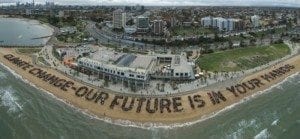 Seems every day there is a new rally related to the environment. Usually they’re in Washington D.C., and usually they’re related to a specific environmental policy or business decision citizens are asking politicians to stop.
Seems every day there is a new rally related to the environment. Usually they’re in Washington D.C., and usually they’re related to a specific environmental policy or business decision citizens are asking politicians to stop.
But in the 21st century, should we re-evaluate the effectiveness of a rally? In a recent episode of the (will be short-lived) NBC sitcom 1600 Penn, a group of environmental activists are protesting in front of the White house. An ill-witted first son unknowingly engages the protesters and parleys a sit-down with the President. Spoiler alert: the President pacifies them without offering any tangible response, and the protesters leave star struck and happy.
What’s this got to do with climate change in the real world? We have to consider the reality of a media-saturated, socially-networked, wi-fi world and the impact this connectivity has on the efficacy of an in-person rally.
Yes, it feels good to connect with others who feel the same way, and it feels good to know you’re part of a cognitive community. A hive if you will. But does it do any political, environmental or other good? Does it impact the issue at hand? I wrote my thesis on community organizing techniques. And I found one constant: the human element is the most impactful.This means every tactic that involves direct human-to-human contact is more effective than, say, a yard sign, bumper sticker, or Google ad. But does this impact spread to situations of peaceful protest? Or does the protest simply take time, resources and energy away from the issue and the people that are shaping it? I would argue the latter.
So, climate changeologists, it’s time to re-think strategy. It’s time to find ways to engage the populace, the skeptics and the fence-sitters in a forward thinking manner. Here’s a brief game plan, please add your thoughts in the comments below.
- Develop a vibrant and engaged internet community. Despite every webmaster’s dream, Facebook remains the social networking tool that meets almost every need. Abandon the futile attempts to build this community on your own website. Reach 600 Million potential activists through the only platform more popular than television.
- Break activism into infant-sized bites. Forget asking for sweeping and universal policy changes. Try asking for minuscule adjustments and a few lines of change. How do you eat an elephant? One bite at a time. Move this mountain one shovel at a time, and the skeptics won’t even know what happened.
- Traditional organizing* is dead. People walk down the street staring at their mobile device instead of looking at your picket line. It’s a hard truth, but “grassroots” might as well be the name of an app, not a community organizing technique. *I respect the hell out of Si Kahn, but it’s time to adapt the strategies into the new world order.
——————-
Dusty is a social scientist and consultant in Vermont.
Image credit: Reposter



Cyrus, I write as one who participated in the San Francisco Climate Rally. I understand what you mean about it being a convention of the converted but we also need to meet, in real person, all those other people that we usually only connect with in blogs or webpages. Online can feel like a lonely place without the physical personal connections. My biggest joy was watching the children and young adults running and playing under the big parachute.
The rally though, served another purpose. On Facebook I feel like a lone wolf among many friends and family who are less committed to environmental causes (though most are committed to other causes). I get to connect with the flesh and blood electronic connections and am reinvigorated.Being able to post about being at the rally got me more likes and comments than most other posts from friends and family. Instead of forwarding them tips admonishing them to use less gas or plastic I could share the joy of the day.
The San Francisco rally was held at a central tourist location (that being said, most of San Francisco is a tourist location) next to a street fair, the bayfront and the Ferry Building. This is a spot where people come to relax, see singularly unique city and citizenry and are open to thinking outside the box, even if for just a few days; they are not glued to their cell phones (except to take photos!). Many of the denizens of the Bay Area actually take the weekends to disconnect from their electronic apparatus on their day off – it reminds them of their day jobs.
The rally may serve new purposes but they are not a bygone institution.